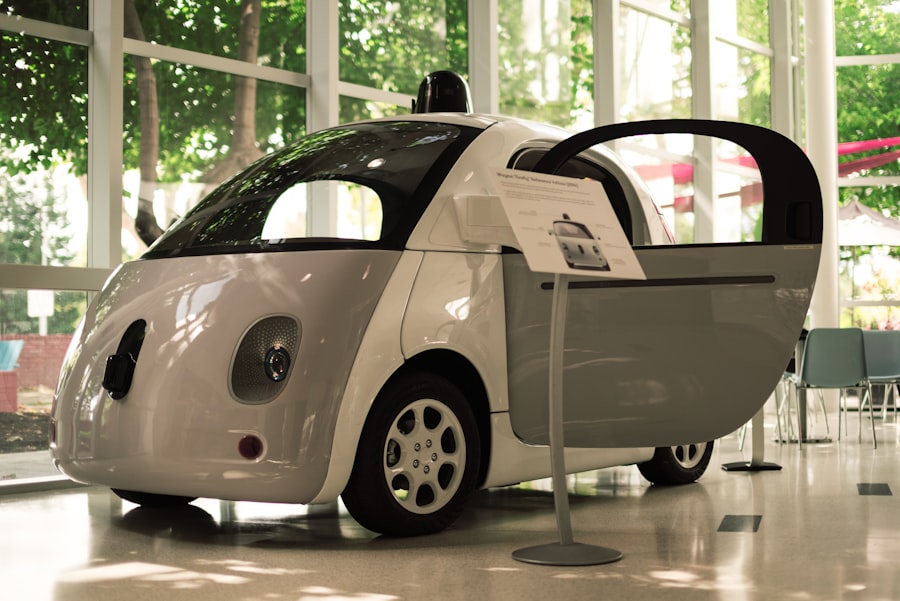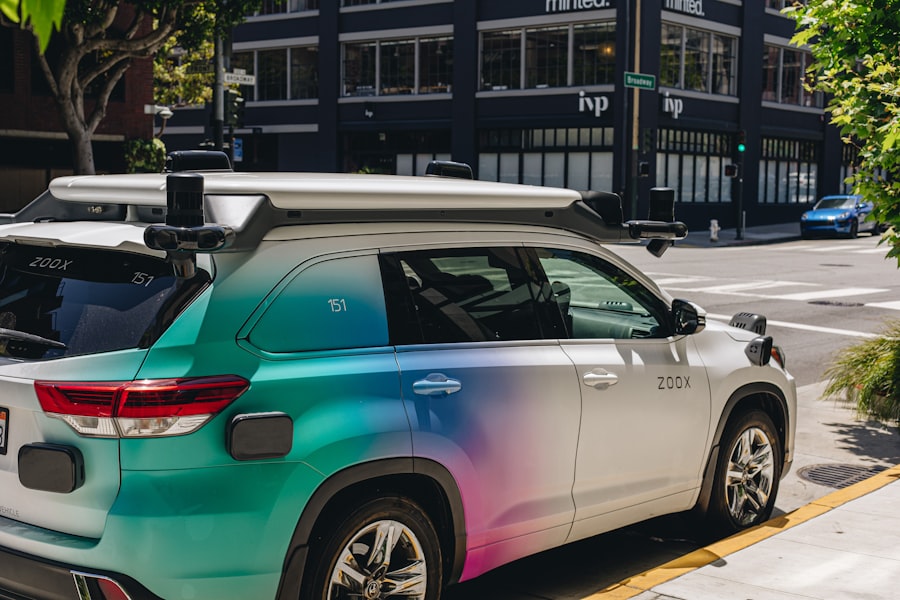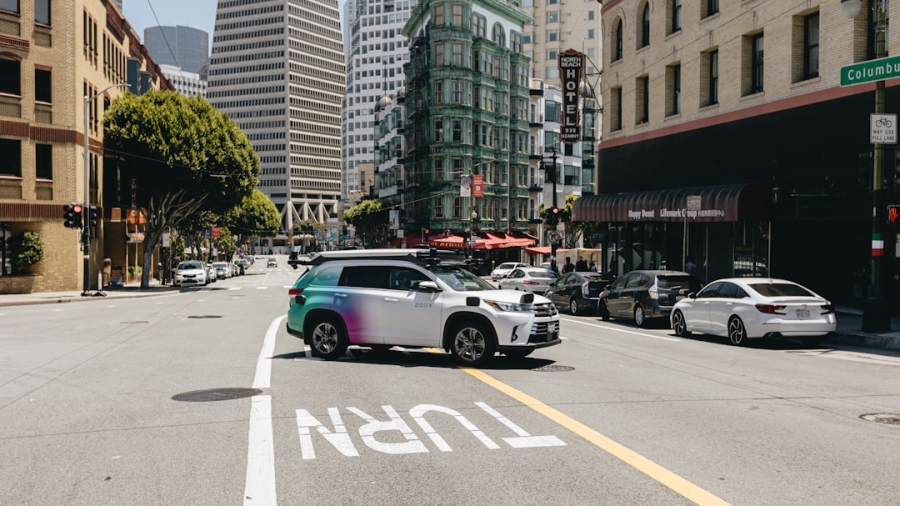The advent of artificial intelligence (AI) has ushered in a transformative era for various industries, with the automotive sector standing at the forefront of this revolution. Autonomous vehicles, often referred to as self-driving cars, leverage sophisticated AI algorithms to navigate and operate without human intervention. This technology integrates a multitude of sensors, cameras, and machine learning models to interpret the surrounding environment, make real-time decisions, and ensure safe travel.
The implications of AI in autonomous vehicles extend beyond mere convenience; they promise to redefine urban mobility, enhance road safety, and reduce traffic congestion. As we delve deeper into this subject, it becomes evident that AI is not just a tool for automation but a catalyst for a paradigm shift in how we perceive transportation. The integration of AI into autonomous vehicles is not merely about replacing human drivers; it represents a comprehensive approach to rethinking transportation systems as a whole.
By harnessing vast amounts of data collected from various sources, including vehicle-to-vehicle (V2V) and vehicle-to-infrastructure (V2I) communications, AI can optimize driving patterns and improve overall traffic dynamics. This technological evolution is poised to address some of the most pressing challenges faced by modern cities, such as increasing traffic volumes, environmental concerns, and the need for sustainable urban planning. As we explore the multifaceted role of AI in autonomous vehicles, it becomes clear that its potential extends far beyond individual vehicles, influencing broader traffic management systems and urban infrastructure.
Key Takeaways
- AI plays a crucial role in the development and operation of autonomous vehicles, enabling them to perceive and respond to their environment.
- AI improves safety and efficiency in traffic management by analyzing real-time data to optimize traffic flow, reduce accidents, and minimize congestion.
- Predictive maintenance for autonomous vehicles is made possible through AI, which can anticipate and prevent potential mechanical issues before they occur.
- AI has a significant impact on traffic flow and congestion management by coordinating traffic signals, managing lane usage, and adjusting speed limits in real time.
- The integration of AI and smart infrastructure allows for more effective traffic control, with AI systems communicating with traffic lights, road signs, and other infrastructure to optimize traffic flow and reduce congestion.
- Ethical and legal considerations surrounding AI in autonomous vehicles include issues of liability, privacy, and decision-making in emergency situations.
- The future of AI in autonomous vehicles and traffic management holds promise for further advancements in safety, efficiency, and sustainability, with continued development and integration of AI technologies.
How AI Improves Safety and Efficiency in Traffic Management
One of the most significant advantages of AI in traffic management is its ability to enhance safety on the roads. Traditional traffic systems often rely on fixed signals and human oversight, which can lead to inefficiencies and increased accident rates. In contrast, AI-driven systems utilize real-time data analytics to monitor traffic conditions continuously.
By analyzing patterns in vehicle movement, pedestrian behavior, and environmental factors, AI can predict potential hazards and adjust traffic signals accordingly. This proactive approach not only minimizes the likelihood of collisions but also ensures that emergency vehicles can navigate through congested areas more effectively, thereby saving lives and reducing response times. Moreover, AI contributes to efficiency in traffic management by optimizing traffic flow.
Through advanced algorithms that process data from various sources—such as GPS signals from vehicles, traffic cameras, and sensors embedded in roadways—AI can dynamically adjust traffic signals to minimize wait times at intersections. This capability is particularly crucial during peak hours when congestion is most pronounced. By streamlining the movement of vehicles and pedestrians alike, AI not only enhances the overall travel experience but also reduces fuel consumption and emissions.
The result is a more sustainable urban environment where transportation systems are not just reactive but actively work to improve the quality of life for all road users.
The Role of AI in Predictive Maintenance for Autonomous Vehicles

Predictive maintenance is another critical area where AI plays a transformative role in the realm of autonomous vehicles. Unlike traditional maintenance practices that often rely on scheduled checks or reactive repairs after a failure occurs, predictive maintenance employs AI algorithms to analyze data from various vehicle sensors in real time. This data-driven approach allows for the early detection of potential issues before they escalate into significant problems.
For instance, by monitoring engine performance, tire pressure, and brake functionality, AI can forecast when a component is likely to fail and alert operators or fleet managers accordingly. This not only enhances vehicle reliability but also significantly reduces downtime and maintenance costs. Furthermore, the implications of predictive maintenance extend beyond individual vehicles to entire fleets of autonomous cars.
Fleet operators can leverage AI to optimize maintenance schedules based on usage patterns and performance metrics across their entire fleet. This holistic view enables more efficient resource allocation and ensures that vehicles are always operating at peak performance levels. As autonomous vehicles become more prevalent in ride-sharing services and logistics operations, the ability to predict maintenance needs will be crucial for maximizing operational efficiency and minimizing disruptions.
In essence, AI-driven predictive maintenance not only enhances the longevity of autonomous vehicles but also contributes to a more reliable transportation ecosystem.
AI’s Impact on Traffic Flow and Congestion Management
The impact of AI on traffic flow and congestion management cannot be overstated. As urban populations continue to swell, cities face unprecedented challenges related to traffic congestion, which can lead to increased travel times, higher emissions, and diminished quality of life for residents. AI technologies offer innovative solutions to these pressing issues by enabling smarter traffic management systems that adapt to real-time conditions.
For example, AI can analyze data from various sources—such as traffic cameras, GPS devices, and social media feeds—to identify congestion hotspots and implement measures to alleviate them. This might include adjusting traffic signal timings or rerouting vehicles through less congested areas. Moreover, AI’s ability to predict traffic patterns based on historical data allows for more effective long-term planning.
By understanding peak travel times and common routes taken by commuters, city planners can make informed decisions about infrastructure investments and public transportation enhancements. Additionally, AI can facilitate better communication between vehicles and traffic management systems through V2I technology. This integration allows for real-time updates on road conditions, accidents, or construction work, enabling drivers to make informed decisions about their routes.
Ultimately, the application of AI in traffic flow management not only enhances efficiency but also fosters a more responsive urban environment that prioritizes the needs of its inhabitants.
The Integration of AI and Smart Infrastructure for Traffic Control
The integration of AI with smart infrastructure represents a significant leap forward in traffic control systems. Smart infrastructure encompasses a range of technologies designed to improve the efficiency and safety of transportation networks through enhanced connectivity and data sharing. By embedding sensors and communication devices within roadways, bridges, and traffic signals, cities can create an interconnected ecosystem that provides real-time information about traffic conditions.
When combined with AI analytics, this infrastructure can facilitate dynamic responses to changing conditions on the roadways. For instance, if an accident occurs on a major thoroughfare, smart infrastructure can quickly relay this information to nearby vehicles and adjust traffic signals to redirect traffic away from the incident. Furthermore, this integration allows for a more holistic approach to urban mobility that encompasses not just vehicles but also pedestrians and cyclists.
AI can analyze data from various modes of transportation to create a comprehensive view of how people move within a city. This information can inform decisions about where to place bike lanes, pedestrian crossings, or public transit stops—ultimately leading to a more balanced transportation network that accommodates diverse needs. As cities continue to evolve into smart urban environments, the synergy between AI and smart infrastructure will be pivotal in creating safer, more efficient transportation systems that enhance the overall quality of life for residents.
Ethical and Legal Considerations of AI in Autonomous Vehicles

As with any groundbreaking technology, the rise of AI in autonomous vehicles brings forth a host of ethical and legal considerations that must be addressed. One of the most pressing ethical dilemmas revolves around decision-making in critical situations—often referred to as the “trolley problem.” In scenarios where an accident is unavoidable, how should an autonomous vehicle prioritize the safety of its occupants versus pedestrians or other road users? These moral quandaries challenge developers and policymakers alike as they strive to create algorithms that reflect societal values while ensuring public safety.
Legal frameworks also face significant challenges in keeping pace with technological advancements in autonomous driving. Questions surrounding liability arise when accidents occur involving self-driving cars: Who is responsible—the manufacturer, software developer, or vehicle owner? Additionally, regulatory bodies must grapple with establishing standards for testing and deploying autonomous vehicles on public roads while ensuring compliance with existing traffic laws.
As these discussions unfold, it becomes increasingly clear that collaboration among technologists, ethicists, lawmakers, and the public will be essential in shaping a future where AI-driven vehicles operate safely and responsibly within our communities.
The Future of AI in Autonomous Vehicles and Traffic Management
Looking ahead, the future of AI in autonomous vehicles and traffic management appears both promising and complex. As technology continues to advance at an unprecedented pace, we can expect further innovations that enhance the capabilities of self-driving cars while improving overall transportation systems. The integration of 5G networks will enable faster data transmission between vehicles and infrastructure, allowing for even more sophisticated real-time decision-making processes.
Additionally, advancements in machine learning will enhance the ability of autonomous vehicles to learn from their environments over time—improving their performance in diverse driving conditions. Moreover, as cities increasingly adopt smart infrastructure solutions powered by AI, we may witness a shift toward more sustainable urban mobility models that prioritize public transportation and shared mobility services over individual car ownership. This evolution could lead to reduced congestion levels and lower emissions as people embrace alternative modes of transport facilitated by intelligent systems.
Ultimately, the future landscape shaped by AI in autonomous vehicles will require ongoing collaboration among stakeholders across sectors—ensuring that technological advancements align with societal needs while fostering safer, more efficient transportation networks for generations to come.
For those interested in the intersection of technology and automotive advancements, particularly in the realm of artificial intelligence, a related article worth reading is “TechRepublic Helps IT Decision Makers Identify Technologies.” This piece explores various technological innovations and their applications in different sectors, including autonomous vehicles and traffic management systems. It provides insights into how AI is being integrated to enhance the functionality and safety of autonomous vehicles, as well as its role in managing complex traffic networks efficiently. You can read more about this topic by visiting TechRepublic Helps IT Decision Makers Identify Technologies.
FAQs
What is the role of AI in autonomous vehicles?
AI plays a crucial role in autonomous vehicles by enabling them to perceive their environment, make decisions, and navigate safely without human intervention. AI algorithms process data from sensors such as cameras, lidar, and radar to understand the vehicle’s surroundings and make real-time decisions.
How does AI contribute to traffic management?
AI contributes to traffic management by analyzing large volumes of data from various sources such as traffic cameras, GPS systems, and mobile devices to optimize traffic flow, predict congestion, and suggest alternative routes. AI can also control traffic signals and manage traffic in real-time based on the current conditions.
What are the benefits of using AI in autonomous vehicles and traffic management?
The use of AI in autonomous vehicles and traffic management can lead to improved road safety, reduced traffic congestion, lower emissions, and enhanced overall transportation efficiency. AI can also enable vehicles to communicate with each other and with infrastructure, leading to a more coordinated and efficient transportation system.
What are some challenges associated with the use of AI in autonomous vehicles and traffic management?
Challenges associated with the use of AI in autonomous vehicles and traffic management include ensuring the reliability and safety of AI algorithms, addressing ethical and legal considerations, and managing the transition from traditional to AI-enabled transportation systems. Additionally, there are concerns about cybersecurity and privacy in the context of AI-driven transportation.

